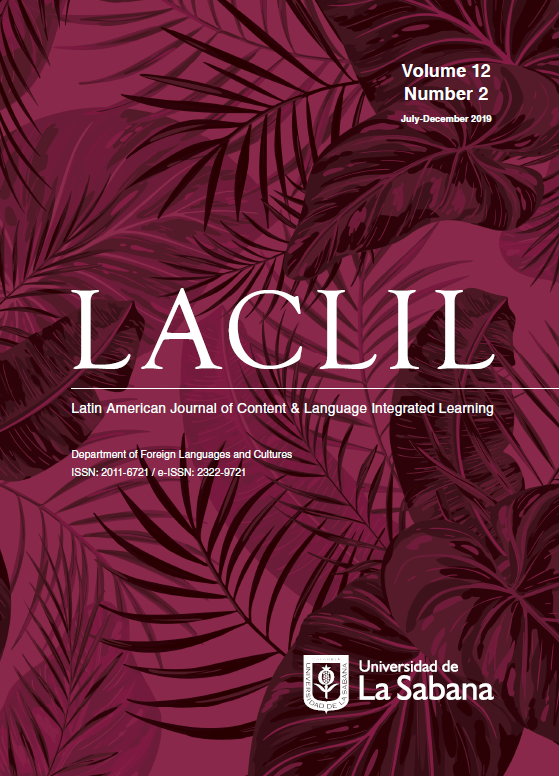What is next for CLIL Professional Development?
DOI:
https://doi.org/10.5294/laclil.2019.12.2.1Resumen
¿Qué sigue para el desarrollo profesional en AICLE?
O que vem agora para o desenvolvimento profissional em CLIL?
To reference this editorial (APA) / Para citar esta editorial (APA) / Para citar este editorial (APA)
McDougald, J. (2019). What is next for CLIL professional development? Latin American Journal of Content & Language Integrated Learning, 12(2), 197-206. https://doi.org/10.5294/laclil.2019.12.2.1
Descargas
Citas
Aiello, J., Di Martino, E., & Di Sabato, B. (2015). Preparing teachers in Italy for CLIL: Reflections on assessment, language proficiency and willingness to communicate. International Journal of Bilingual Education and Bilingualism, 0050(November), 1–15. http://dx.doi.org/10.1080/13670050.2015.1041873
Banegas, D. L. (2019). Teacher professional development in language-driven CLIL: A case study. Latin American Journal of Content & Language Integrated Learning, 12(2), 242-264. https://doi.org/10.5294/laclil.2019.12.2.3
Borko, H. (2007). Professional development and teacher learning: mapping the terrain. Educational Researcher, 33(8), 3–15. http://dx.doi.org/10.3102/0013189x033008003
Bruton, A. (2011). Are the differences between CLIL and non-CLIL groups in Andalusia due to CLIL? A reply to Lorenzo, Casal and Moore (2010). Applied Linguistics. http://dx.doi.org/10.1093/applin/amr007
Custodio, M. (2019). Influencing factors on in-service teachers’ competence in planning CLIL. Latin American Journal of Content & Language Integrated Learning, 12(2), 207-241. https://doi.org/10.5294/laclil.2019.12.2.2
Freeman, D., Reynolds, D., Toledo, W., & Abu-Tineh, A. M. H. (2016). Who provides professional development? A study of professional development in Qatar. Iranian Journal of Language Teaching Research, 4(3), 5–19.
Frigols-Martin, M. J. (2011). The European framework for CLIL teacher education. Language Teaching, 44(3), 401–402. http://dx.doi.org/10.1017/S0261444811000243
Murillo-Caicedo, A. J. (2016). Coaching for CLIL: A training proposal for non-CLIL content primary teachers in the Principado de Mónaco Bilingual School (Published Master’s thesis), Universidad Internacional de La Rioja.
Nikula, T., Dalton-Puffer, C., & García, A. L. (2013). CLIL classroom discourse: Research from Europe. Journal of Immersion and Content-Based Language Education. http://dx.doi.org/10.1075/jicb.1.1.04nik
Pérez-Cañado, M. L. (2016a). Are teachers ready for CLIL? Evidence from a European study. European Journal of Teacher Education, 39(2), 202–221. http://dx.doi.org/10.1080/02619768.2016.1138104
Pérez-Cañado, M. L. (2016b). Evaluating CLIL Programmes: Instrument design and validation. Pulso, 39, 79–112.
Reza, M. (2019). Feasibility of adopting English as a partial Medium of Instruction for mathematics and science subjects in Iranian senior high schools. Latin American Journal of Content & Language Integrated Learning, 12(2), 292-320. https://doi.org/10.5294/laclil.2019.12.2.5
Santana, J. del C. (2019). Establishing teacher-student rapport in an English medium instruction class. Latin American Journal of Content & Language Integrated Learning, 12(2), 265-291. https://doi.org/10.5294/laclil.2019.12.2.4
Tatzl, D. (2011). English-medium masters’ programmes at an Austrian university of applied sciences: Attitudes, experiences and challenges. Journal of English for Academic Purposes, 10(4), 252–270. http://dx.doi.org/10.1016/j.jeap.2011.08.003
Vázquez, V. P., & Ellison, M. (2013). Examining teacher roles and competences in (CLIL). Lingvarum Arena, 4(CLIL), 65–78.
Vilkancienė, L., & Rozgienė, I. (2017). CLIL Teacher competences and attitudes. Sustainable Multilingualism, 11(1), 196–218. http://dx.doi.org/10.1515/sm-2017-0019
Descargas
Publicado
Cómo citar
Número
Sección
Licencia
Los autores que publican en esta revista están de acuerdo con los siguientes términos:
Esta revista y sus artículos se publican bajo la licencia Creative Commons Atribución-NoComercial-SinDerivadas 4.0 Internacional (CC BY-NC-ND 4.0), por lo cual el usuario es libre de: compartir, copiar y redistribuir el material en cualquier medio o formato, siempre y cuando: dé crédito de manera adecuada, brinde un enlace a la licencia e indique si se han realizado cambios; no use nuestro contenido con propósitos comerciales; y/o remezcle o transforme el material. Recuerde que no tiene los permisos para distribuir el material si fue modificado.








